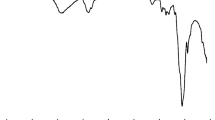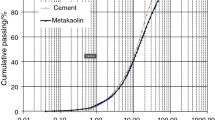Abstract
The potential degradation of calcium aluminate cement (CAC) concrete due to the conversion of thermodynamically metastable compounds into stable phases is a well-known phenomenon. This research focuses on the effects of polymers on the hydration kinetics and strength development of calcium aluminate cement (CAC) mortars at two curing temperatures, i.e., 200 °C and 38 °C. The constant CAC content was used to prepare mortars. However, the sand was replaced by acrylic polymer (AP) (5%), vinyl acetate monomer/vinyl versetate polymer (VA/VV) (2%), and two different Poly (vinyl alcohol-co-vinyl acetate) (PVAc) (2%). Isothermal calorimetric investigations for 3 days, capillary absorption tests, flexural strength tests and compressive strength tests at 3, 7, 28, and 90 days were conducted. The hydration reactions of CAC mortars accelerated by replacing sand with polymer admixtures. The flexural strength of CAC mortar with the AP exhibited on-par compressive strength values at 20 °C. All the polymer-incorporated samples except VA/VV displayed an increase in their late-age mechanical properties than 28 days results, showing promising results for reduction in strength decline at a later stage. The PVAc-73 (i.e., 73% hydrolysis degree)-incorporated mortar was unaffected by increased curing temperature. The mortars exhibited early hydration behavior at increased temperatures.








Similar content being viewed by others
Data availability
The data, codes, and models devised or utilized in this research are presented in the submitted article.
Abbreviations
- CAC:
-
Calcium aluminate cement
- CAC-SP:
-
Calcium aluminate cement with superplasticizer
- OPC:
-
Ordinary Portland cement
- OPC-SP:
-
Ordinary Portland cement with superplasticizer
- AP:
-
Acrylic polymer
- VA/VV:
-
Vinyl acetate monomer/vinyl versetate polymer
- PVAc-73:
-
Poly(vinyl alcohol-co-vinyl acetate)-PVAc (73.2% hydrolysis degree)
- PVAc-79:
-
Poly(vinyl alcohol-co-vinyl acetate) PVAc (79.4% hydrolysis degree)
References
Bizzozero J. Hydration and dimensional stability of calcium aluminate cement-based systems, PhD. Thesis, Faculty Science and Technology De L'ingénieur, Switzerland. 2014. https://doi.org/10.5075/epfl-thesis-6336.
Warmuz K, Madej D. Comparison of the CAC-containing and CAC-free hydraulic binders in term of the hydrated matrix formation within refractory castables designed for the fast-drying procedure. J Therm Anal Calorim. 2022. https://doi.org/10.1007/s10973-022-11351-2.
Jambor J, Skalny J. Another look at the deterioration of calcium aluminate cement concrete. Mater Constr. 1996;46:5–21. https://doi.org/10.3989/mc.1996.v46.i241.537.
Bentivegna AF. Multi-scale characterization, implementation, and monitoring of calcium aluminate cement based-systems, PhD Thesis, The University of Texas at Austin, USA. 2012. http://hdl.handle.net/2152/ETD-UT-2012-05-5219.
Ukrainczyk N, Rogina A. Styrene–butadiene latex modified calcium aluminate cement mortar. Cem Concr Compos. 1996;41:16–23. https://doi.org/10.1016/j.cemconcomp.2013.04.012.
Midgley HG. High alumina cement in construction-a future based on experience, calcium aluminate cement. In: Mangabhai RJ, editor. London: Chapman and Hall; 1990. p. 1–13.
Midgley HG. Quantitative determination of phases in high alumina cement clinkers by X-ray diffraction. Cem Concr Res. 1976;6(2):217–23.
Adams MP, Lute RD, Moffatt EG, Ideker JH. Evaluation of a procedure for determining the converted strength of calcium aluminate cement concrete. J Test Eval. 2018;46:1659–72. https://doi.org/10.1520/JTE20160277.ISSN0090-3973.
Falzone G, Balonis M, Sant G. X-AFm stabilization as a mechanism of bypassing conversion phenomena in calcium aluminate cements. Cem Concr Res. 2015;72:54–68. https://doi.org/10.1016/j.cemconres.2015.02.022.
Idrees M, Ekincioglu O, Sonyal MS. Hydration behavior of calcium aluminate cement mortars with mineral admixtures at different curing temperatures. Constr Build Mater. 2021;285: 122839. https://doi.org/10.1016/j.conbuildmat.2021.122839.
Jiang C, Yuan H, Lu C, Xu Z, Lu D. The effect of nanoparticles on the properties of calcium aluminate cement pastes at high temperatures. Adv Cem Res. 2018;30(5):195–203. https://doi.org/10.1680/jadcr.17.00039.
Saoût GL, Lothenbach B, Taquet P, Fryda H, Winnefeld F. Hydration of calcium aluminate cement blended with anhydrite. Adv Cem Res. 2018;30(1):24–36. https://doi.org/10.1680/jadcr.17.00045.
Wang Z, Zhao Y, Yang H, Zhou L, Diao G, Liu G, Xu L. Influence of sodium chloride on the hydration of calcium aluminate cement constantly cured at 5, 20 and 40 °C. Adv Cem Res. 2021;33(2):84–95. https://doi.org/10.1680/jadcr.19.0004.
Idrees M, Saeed F, Amin A, Hussain T. Improvement in compressive strength of styrene–butadiene–rubber (SBR) modified mortars by using powder form and nanoparticles. J Build Eng. 2021;44: 102651. https://doi.org/10.1016/j.jobe.2021.102651.
Ohama Y. Handbook of polymer modified concrete and mortars-properties and process technology. NJ: Noyes Publications; 1995. https://www.elsevier.com/books/handbook-of-polymer-modified-concrete-and-mortars/ohama/978-0-8155-1358-2.
Idrees M, Akbar A, Saeed F, Saleem H, Hussain T, Vatin NI. Improvement in durability and mechanical performance of concrete exposed to aggressive environments by using polymer. Materials. 2022;15(11):3751. https://doi.org/10.3390/ma15113751.
Shi C, Zou X, Yang L, Wang P, Niu M. Influence of humidity on the mechanical properties of polymer-modified cement-based repair materials. Constr Build Mater. 2020;261: 119928. https://doi.org/10.1016/j.conbuildmat.2020.119928.
Ukrainczyk N, Rogina A. Setting time regulation of polymer modified calcium aluminate cement-based materials. In: Proceedings of international conference on materials, tribology, recycling (MATRIB 2010). Croatian Society for Materials and Tribology, Vela Luka, Croatia, June 23–25, 512–520. ISBN 978-953-7040-18-5; 2010.
Sugama T, Mora RN. Acid-modified calcium aluminate and calcium silicate cements. J Mater Sci. 1996;31:6269–78. https://doi.org/10.1007/BF00354449.
Xu W, Dai JG, Ding Z, Wang Y. Polyphosphate-modified calcium aluminate cement under normal and elevated temperatures: phase evolution, microstructure, and mechanical properties. Ceram Int. 2017;43:15525–36. https://doi.org/10.1016/j.ceramint.2017.08.102.
Birchall JD, Kendall K, Howard AJ. Cementitious product, European Patent Office: EP0021682; 1981.
Ekincioglu O, Özkul MH, Struble LJ, Patachia S. State of the art of macro-defect-free composites. J Mater Sci. 2018;53:10595–616. https://doi.org/10.1007/s10853-018-2328-y.
Tan SR, Howard AJ, Birchall JD. Advanced materials from hydraulic cements. R Soc. 1987;322:479–91. https://doi.org/10.1098/rsta.1987.0066.
Šoukal F, Ptáček P, Másilko J, Opravil T, Havlica J, Drdlová M. High temperature properties of MDF composite based on calcium aluminate cement and polyvinyl alcohol. J Therm Anal Calorim. 2014;115:1245–52. https://doi.org/10.1007/s10973-013-3481-9.
Engbert A, Gruber S, Plank J. The effect of alginates on the hydration of calcium aluminate cement. Carbohyd Polym. 2020;236: 116038. https://doi.org/10.1016/j.carbpol.2020.116038.
Wang ZY, Zhao Y, Zhou XL, Diao LG. Effects of hydroxyethyl methyl cellulose ether on the hydration and compressive strength of calcium aluminate cement. J Therm Anal Calorim. 2019;140:545–53. https://doi.org/10.1007/s10973-019-08820-6.
Akhlaghi O, Menceloglu Y, Akbulut O. Poly(carboxylate ether)-based superplasticizer achieves workability retention in calcium aluminate cement. Sci Rep. 2017;7:41743. https://doi.org/10.1038/srep41743.
Ukrainczyk N. Effect of polycarboxylate superplasticizer on properties of calcium aluminate cement mortar. Adv Cem Res. 2015;27(7):388–98. https://doi.org/10.1680/adcr.14.00022.
Koňáková D, Pommer V, Šádková K, Keppert M, Černý R, Vejmelková E. Impact of plasticizers’ types on the performance of calcium aluminate cement. J Mark Res. 2022;20:1512–23. https://doi.org/10.1016/j.jmrt.2022.07.155.
Yuan Q, Liu Z, Zheng K, Ma C. Chapter 2—Inorganic cementing materials. Civil engineering materials. Elsevier; 2021. p. 17–57. https://doi.org/10.1016/B978-0-12-822865-4.00002-7.
BS EN 1015-2. Methods of test for mortar for masonry. Bulk sampling of mortars and preparation of test mortars. London: British Standards Institution; 1999. https://shop.bsigroup.com/ProductDetail?pid=000000000030151072.
ASTM C185-15a. Standard test method for air content of hydraulic cement mortar. West Conshohocken: ASTM International; 2015. https://doi.org/10.1520/C0185-15A
BS EN 196-1. Methods of testing cement. Determination of strength. London: British Standards Institution; 2016. https://shop.bsigroup.com/ProductDetail?pid=000000000030291447.
ASTM C1702-17. Standard test method for measurement of Heat of hydration of hydraulic cementitious materials using isothermal conduction calorimetry. West Conshohocken: ASTM International; 2017. https://doi.org/10.1520/C1702-17.
ASTM C1585-13. Standard test method for measurement of rate of absorption of water by hydraulic-cement concretes. West Conshohocken: ASTM International; 2013. https://doi.org/10.1520/C1585-13.
Knapen E, Gemert DV. Polymer film formation in cement mortars modified with water-soluble polymers. Cem Concr Compos. 2015;58:23–8.
Askarinejad S, Rahbar N. Effects of cement-polymer interface properties on mechanical response of fiber-reinforced cement composites. J Nanomech Micromech. 2017;7:04017002.
Saeedikia A, Madani H. Influence of polymer materials on the durability of calcium aluminate cement based mixtures. J Concr Struct Mater. 2018;3(2):24–40.
Saeedikia A, Madani H. The modifying effects of styrene butadiene rubber and styrene acrylic polymers on the properties of cementitious mixtures with calcium aluminate cement. Sharif J Civ Eng. 2018;37.2(2.2):61–71.
Zhang X, Li G, Song Z. Influence of styrene-acrylic copolymer latex on the mechanical properties and microstructure of Portland cement/calcium aluminate cement/gypsum cementitious mortar. Constr Build Mater. 2019;227: 116666.
BS EN 14647. Calcium aluminate cement. Composition, specifications and conformity criteria. London: British Standards Institution; 2006.
Peng Y, Zhao G, Qi Y, Zeng Q. In-situ assessment of the water-penetration resistance of polymer modified cement mortars by μ-XCT, SEM and EDS. Cem Concr Compos. 2022;114: 103821.
Ma M, Mehdizadeh H, Guo MZ, Ling TC. Effect of direct carbonation routes of basic oxygen furnace slag (BOFS) on strength and hydration of blended cement paste. Constr Build Mater. 2021;304: 124628.
Do TA, Verdugo D, Tia M, Hoang TT. Effect of volume-to-surface area ratio and heat of hydration on early-age thermal behavior of precast concrete segmental box girders. Case Stud Therm Eng. 2021;28: 101448.
Cherop PT, Kiambi SL, Kosgey EK. Influence of vinyl acetate-ethylene copolymer on early-age ettringite formation and behavior in OPC/CAC/hemihydrate gypsum binder system: A case of higher CAC content than OPC content in the binder. Int J Appl Eng Res. 2017;12(1):11–21.
Engbert A, Plank J. Identification of specific structural motifs in biopolymers that effectively accelerate calcium alumina cement. Ind Eng Chem Res. 2020;59:11930–9.
Kotera M, Matsuda I, Miyashita K, Adachi N, Tamura H. Hydration process for calcium-aluminate cement within EVA emulsion by SPring-8 synchrotron radiation X-ray diffraction method. J Soc Mater Sci Jpn. 2005;54(7):780–4.
Zhao H, Yang Y, Shu X, Wang Y, Wu S, Ran Q, Liu J. The binding of calcium ion with different groups of superplasticizers studied by three DFT methods, B3LYP, M06–2X and M06. Comput Mater Sci. 2018;152:43–50.
Acknowledgements
The authors are highly obliged to Cimsa Cement Company, which supplied calcium aluminate cement and Nippon Gohsei and Organik Kimya for supplying polymers for this study.
Funding
The Higher Education Commissions of Pakistan (HEC) and Turkey (YÖK) have provided the "Pak Turk Researchers' Mobility Grant" [Grant Numbers No. 9-5(Ph-1-MG-11)-PAK TURK/R&D/HEC/2017 (Pakistan), MEV-2017-527(Turkey)]. The research has been conducted under the international collaboration of UET Lahore and ITU Istanbul.
Author information
Authors and Affiliations
Contributions
There is no conflict of interest among researchers. All authors have contributed almost equally.
Corresponding author
Additional information
Publisher's Note
Springer Nature remains neutral with regard to jurisdictional claims in published maps and institutional affiliations.
Rights and permissions
Springer Nature or its licensor holds exclusive rights to this article under a publishing agreement with the author(s) or other rightsholder(s); author self-archiving of the accepted manuscript version of this article is solely governed by the terms of such publishing agreement and applicable law.
About this article
Cite this article
Idrees, M., Ekincioglu, O. & Sonyal, M.S. The hydration behavior of polymer-incorporated calcium aluminate cement mortars at different curing temperatures. J Therm Anal Calorim 147, 13201–13215 (2022). https://doi.org/10.1007/s10973-022-11671-3
Received:
Accepted:
Published:
Issue Date:
DOI: https://doi.org/10.1007/s10973-022-11671-3




